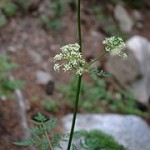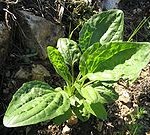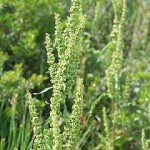by Catherine Haug
Jean H. and I attended the Crop Circle presentation on herbology yesterday evening, in the basement of the Kalispell Public Library. What follows are my notes from this 2-hour presentation.
Presenter: Sheryl Eaglewoman
Sheryl is a health consultant in the Wise Woman tradition. She has over 20 years experience in midwifery, healing, wellness, nutrition, and energy work as a medical intuitive. Her website is LivingResponsibly.com; check out her articles (“Columns“), via a link on the left-hand side of her website.
Her teacher and mentor is Susun Weed (www.susunweed.com). In addition, she worked for many years in the supplements aisle of Whole Foods.
Next month, Sheryl will discuss homeopathy (July 29, 2009). See also her article on the subject: Living Responsibly-Homeopathy (also saved: Health-Nutrition / Podcasts-Articles / SherylEaglewoman > LivingResponsibly_Homeopathy_SEaglewoman.pdf
See also Cat’s article (July 2009): Introduction to Homeopathy [Cat’s Note: Here’s an updated October 2022 version: Introduction to Homeopathy (from Cat’s Kitchen)]
Healing Traditions
Sheryl briefly described three healing traditions, noting that all have similarities as well as differences throughout the world, regarding concepts of energy, wet/dry and hot/cold body balancing:
- Wise Woman Tradition, treats with health/wellness as the goal: “Where your head goes, your body follows.” If you focus on disease, you will not get well. For example, the periodic breast self-exam: we are taught to look for lumps, but this opens the door to the possibility of disease; better to look for healthy tissue.
- Heroic Tradition, which includes cleansing, blood-letting and other heroic efforts toward wellness.
- Scientific Tradition, which treats by ‘fixing’ and stabilizing symptoms, but not necessarily dealing with the root cause.
Achieving Wellness
Sheryl defines wellness as an ability to thrive, expand. It’s not just about you but also about the earth: getting enough sunlight, clean water and clean air; moving your body as much as your mouth; breathe; self acceptance.
An absence of wellness can always be traced to one (or two) underlying cause(s).
From Sheryl’s perspective, when you have a health issue, consider the following steps, in order of practice:
- Do nothing: take time to observe and collect your thoughts. Depending on the situation, this could take just a moment, or several days/weeks/months.
- Use energy to effect the situation: smiling, empathy, music, flower essences, etc..
- Address with nutrition: real foods and nutritional herbs. This category also includes sunlight and clean water. By real foods, she means whole, fresh or naturally preserved or prepared foods; avoid anything in a box or package. Always select organically-raised foods, for your health and for the health of the earth. Nutritional herbs include nourishing and tonic herbs, such as slippery elm, nettles and plantain. Also cooking herbs like rosemary, basil, thyme and sage.
- Address with supplements; this includes vitamins and potentially toxic herbs such as poke and lobellia.
- Address with drugs (pharmaceuticals and synthetically-produced supplements).
- Address with surgery. This should always be a last resort. Then after the surgery, repeat the steps in backward order to restore to a functional state.
Questions to Ask During Treatment
- Is this forcing or assisting the body? if forcing, go back to step 1 (do nothing) and proceed. Maybe forcing is the right thing to do, but give it good thought before proceeding. Perhaps assisting is more appropriate. This can only be decided while you “do nothing.”
- If assisting, how is it assisting? She gave an example of her knee. She relocated here about 3 years ago, and the move was fairly stressful, as she knew no one here. She is an avid hiker, but noticed one day that her knee was hurting. Giving thought to her body situation, she realized it was expressing her stress. Realizing this and addressing the stress brought instant healing to her knee.
- Am I looking full-spectrum? That is, at the whole lifestyle and at all symptoms and conditions. Sheryl uses a “differential diagnosis,” which means very specific observations are needed. For example, are the fingers blue? Is the face red? Is there snoring? Also, ask the person what he/she is experiencing.
- Is the experience a symptom or a cause? An example of this is the condition of insomnia. You might want to treat it as a cause, by giving a sedative. But insomnia is usually a symptom of liver congestion: the liver works at night, causing symptoms such as night sweats, which wake you up. If liver congestion is the cause of the insomnia, it is better to treat and support the liver (more on this later). Also, the liver is the seat of anger; if you are suppressing anger, this can cause insomnia. Sheryl cited an example of a woman who had undetected hepatitis-C for years after receiving an injection. But then a traumatic event happened, which affected the hypothalamus, and in turn affected the liver’s ability to detox effects of the hepatitis, causing the hepatitis to flare up in severe symptoms.
Herbal Pharmacy
Sheryl listed several herbs everyone should keep in their home pharmacy; some can even be grown here:. These can be prepared in several ways:
- Tteas: steep the herb in hot water, then drink.
- Infusion: a much stronger tea (use more of the herb, at least double).
- Decoction: cook down an infusion by at least half the liquid volume. [Many Chinese healing teas are of this variety.]
- Oil: use fresh, not dried plant. Do not wash it, but brush off dirt. Soakplant in oil (organic olive or coconut oil are best) in sealed jar. Let sit in warm spot, but not in a window.
- Salve: similar to oil (she didn’t explain the difference)
- Tinctures: extraction of the herb’s essence into alcohol, glycerin or vinegar. Alcohol tinctures are preferred, as they will maintain potency for at least 5 years. Glycerin tinctures will last 6 months after opening. Vinegar tinctures have no shelf life, and must be taken immediately after making.
When preparing tinctures, Sheryl prefers fresh over dried herbs; but for teas, she prefers dried over fresh, because the drying process breaks the cell walls so that the essence is more easily extracted with water.
Note about dosages on commercial herbal supplements: These are for 120 – 150 pound person. if lighter or heavier than this, adjust accordingly. For example, a 60 -75 pound child would get a half-dose. A 200 pound person would get 1 1/3 dose.
Sheryl’s guide for picking the right herb has to do with color and where the problem is seated. She applies a rainbow, with violet at the head, yellow in the midsection, and red at the feet. So, violets would be good for head problems; yellow herbs (yellow dock, dandelion) are good for the liver.
Sheryl’s Short List of Favorite Herbs for Wellness
(photos from wikipedia; see sources):
 Osha root
Osha root
(also known as mountain ginseng, Colorado cough root, Indian root, wild lovage, porters lovage, or mountain carrot). This member of the parsley family does not like to be cultivated, but grows wild in the Rocky Mountain range from Mexico to Canada. Native Americans used it to treat colds, flu, and upper respiratory infections (1). It has a very earthy, smoky scent. Medicinal properties include: strong affinity for the respiratory system; excellent for lung congestion and snakebite; antimicrobial, including anti-viral and anti-fungal.
 Hawthorne leaves and flowers
Hawthorne leaves and flowers
This is a heart remedy and powerful antioxidant, and grows in our area. VERY important to treat GMO diseases. Scientific research using microbes for genetic engineering has unleashed a pandora’s box of new, highly resistant forms of diseases such as strep throat. Hawthorne is one of the few herbs effective against these.
 Plantain leaves
Plantain leaves
(also known as Soldier’s herb): While not native to our area, it has naturalized here and is a common yard “weed.” Known as a wound healer and snakebite remedy, it acts by moving the lymphatics. Typically used topically as an oil or salve, but can be taken internally as a tincture for fungus of fingers and toes.
 Yellow Dock root
Yellow Dock root
(also known as curly dock). While the root is used medicinally, the leaves are good in salads. Used to treat iron deficiency (even though it has little iron in it), and is a liver tonic. Good for skin ailments caused by congested liver, such as rashes, eczema, etc.. Also for poor digestion and mild constipation.
Chamomile
Very soothing.
Dragon’s Blood
Blood purifier and is taken internally. It is a heady herb.
Saw Palmetto
Used to treat prostate problems.
Rosemary
Excellent for treating a GMO version of mumps.
Basil
Holy Basil encourages a feeling of calmness; sweet basil is also good.
Liver Issues
- Insomnia, constipation, acne, fibroids, bad attitude, reproductive elements can usually be traced to the liver.
- Liver is active between 1 and 4 AM;
- Liver moves the pelvis and the gut;
- Liver and thyroid are closely related: An unwell liver smolders the thyroid; an unwell thyroid fries the liver.
Liver Herbs:
- milk thistle (for repair)
- dandelion (for detox), both green leaves and root, best if fresh. High in inulin, which also supports the pancreas
- yellow dock
- sunlight
Thyroid Herb:
Coleus forskohlii. Balances metabolism via mitochondria. Also supports adrenals. This is an ancient Ayurvedic plant. Sheryl talked about cAMP, but I couldn’t keep up in my notes, so here’s a quote from Indo-World (6):
“Forskolin’s basic mechanism of action is that it increases the amount of cyclic AMP (adenosine monophosphate) in cells by activating an enzyme called adenylate cyclase. Cyclic AMP (cAMP) is one of the most important secondary messengers in the cell. It is considered to be one of the most important cell regulating compounds.
Under normal circumstances, cAMP forms by adenylate cyclase activation due to hormonal stimulation at the cell receptor site. However, forskolin seems to bypass this reaction and allows for an increase in intracellular cAMP to occur. Why is it important to increase cAMP levels? Well, there are several benefits of this to athletes including relaxation of the arteries and smooth muscles, lowering blood pressure, enhanced insulin secretion (which can help drive carbohydrates and protein into muscle cells for energy and recovery), increased thyroid hormone function (which can help enhance metabolic rate), and significantly increase lipolysis (fat burning). Forskolin also seems to benefit other cellular enzymes as well.
The breakdown of fat for fuel (lipolysis) is actually regulated by cAMP. Forskolin has been shown to not only enhance lipolysis but it may also inhibit fat storage from occurring. This is very good news for individuals trying to lose bodyfat and get lean. Another way that forskolin may allow for fat loss to occur is by stimulating thyroid hormone production and release. Thyroid hormone controls metabolism and can enhance metabolic rate, which may translate into more fat loss.
One of the overlooked benefits of forskolin includes its stimulation of digestive enzymes, which can allow individuals to digest and assimilate their food better. It has been shown to increase nutrient absorption in the small intestine.”
Miscellaneous issues
Swine Flu and GMO Bugs
Make your body inhospitable to these organisms, by increasing your resistance and supporting the immune system.
Digestive System
- Always eat sitting down;
- Take enzyme supplements if needed;
- Take Lavender Spirits Compound from herb Pharm; it balances digestivederangement; warms and relaxes the stomach.
Superfood Supplement
New Chapter’s Berry Green: good organic, freeze-dried, whole food supplement rich in antioxidants. No grasses.
Bluebonnet is a good brand – mostly organic and nothing from China. Always lists source of ingredients.
Ginseng
Careful with this, as it is heavily sprayed.